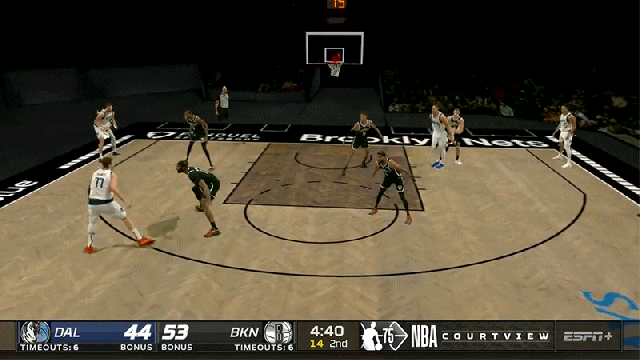The video described in this article might be one of the most distressing things you see today. I don’t mean graphic — more like disturbing in the way you felt watching Ex Machina or when looking into the eyes of the eponymous hero in Alita: Battle Angel. I’m not going to show you a trailer for a movie tackling the uncanny valley — no, complaints about your impending sleep disturbances can be filed to the NBA.
Yes, that NBA. The National Basketball Association. And ESPN, which broadcast last night’s Brooklyn Nets versus Dallas Mavericks game using volumetric video, effectively turning actual human players into video game characters. The below tweet posted by the official NBA account gives us an early glimpse at the new “CourtView” video technology.
The Nets and Mavs went bucket for bucket down the stretch before Dinwiddie’s #TissotBuzzerBeater
Relive the best plays from Mavs vs Nets via NBA CourtView, a new immersive experience using 3D technology! pic.twitter.com/14HEBHRKQx
— NBA (@NBA) March 17, 2022
What’s happening here? Canon Free-Viewpoint Video tech grabs footage from more than 100 data capturing cameras placed around the court to track player movement. The info is combined and processed to create real-time 3D models much like how players are made to look more realistic in video games like NBA2K22. This multi-dimensional footage gives broadcasters the ability to show replays, highlights, or real-time play from any angle on the court, not just from a few fixed cameras.
This alternative broadcast has its own production team and commentators, and actual sounds from Barclays Centre in Brooklyn are piped in to make things more convincing. The resulting footage is rather jarring. It looks similar to a video game, but one from the previous decade that’s plagued by strange artifacts, jagged edges, and a flat, lifeless crowd.
This is worse than NBA 2K Mobile
— BallZtalk (@BallZ_Talk) March 17, 2022
Early reception of this nascent technology has been not so positive, at least, based on what I can glean from social media feeds. The most common reaction is confusion followed by mild discomfort. Others see the value in having a 3D view of the court. As one Twitter user said, CourtView gives you more visual information about the flow of a game, allowing you to better see the spacing between players.
As uncanny valley as it is, I do see the technology being accepted by diehard sports fans as a complement to the more traditional live-action footage. But it won’t become mainstream until some of the technical hurdles are resolved. And with that, I’ll leave you with one final take:
What the fuck is this stupid NBA Courtview bullshit? @espn Where can I watch the regular broadcast? This is awful
— Chaz (@Chazzy_Bear214) March 16, 2022
